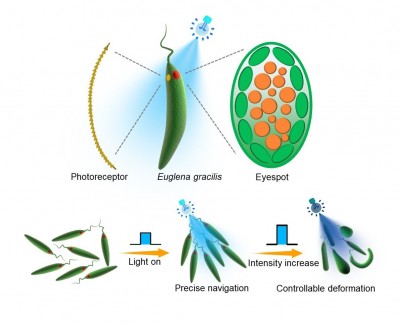Newswise — Micro/nanorobots, due to their small size, high controllability, and precise navigation capabilities, are emerged as an important tool to execute biomedical tasks in microenvironments. However, it is still a big challenge to maneuver rigid microrobots in complicated and sinuous narrow spaces (such as blood vessels and intestines) due to their inability to deform. Developing highly controllable, deformable, and environmental-adaptable soft microrobots is thus very crucial for multiple-task execution in such narrow microenvironments. Yet, it’s still a big challenge to select highly biocompatible materials to construct these microrobots.
In a new paper (doi: 10.1038/s41377-024-01405-5) published in Light: Science & Application, a team of scientists led by Professor Hongbao Xin from Guangdong Provincial Key Laboratory of Nanophotonic Manipulation, Institute of Nanophotonics, Jinan University, China, have developed a smart strategy to transform a microalga (Euglena gracilis, widely found in nature) into a soft bio-microrobot (Ebot) controlled with blue LED light. This microalga holds good biocompatibility and environmental adaptability, and can move free and can deform in the natural living states, however, without controllability. The photoreceptor at the back of the eyespot is extremely sensitive to blue light. Therefore, they used a blue LED light with a center wavelength of 450 nm to control the Euglena gracilis. With different light intensity and irradiation duration, they find that the flagellar beating patterns and epidermal transverse mode sliding can be controlled by activating light-sensitive photoreceptor and calcium ion channels. And the Euglena gracilis is then turned into a light-controlled soft bio-microrobot (Ebot) with the capability of precision navigation and controllable deformation (Figure 1). This light-controlled navigation and deformation allows the Ebot to easily pass through narrow and curved microchannels (Movie 1).
The feature of deformability and high adaptability to different environments allows the Ebot to perform different biomedical tasks in different narrow and changeable microenvironments such as complex microfluidic channels and intestinal mucosa. They have successfully demonstrated the task execution capability of targeted drug delivery and selective removal of diseased cells in intestinal mucosa (Figure 2). More importantly, since Euglena gracilis is rich in chlorophyll, the Ebot can perform photosynthesis to produce oxygen under light irradiation. While chlorophyll can be reduced to chlorophyll derivatives, a natural photosensitizer, under the light irradiation at a wavelength of 670 nm, the Ebot can perform precise photodynamic therapy on cancer cells in target areas. This light-controlled soft microrobot provides a new bio-microrobotic tool that can execute multiple tasks, and will open a new avenue for future microrobotics in biomedical applications within complicated and sinuous narrow microenvironments.
Compared with conventional microrobots with chemical synthetic materials, they are many advantages of this microalga-based Ebot. These scientists summarized the advantages:
“First, without any chemical synthetic materials, the fabrication and control of this Ebot is very easy, and we can control the Ebot (either a single Ebot or multiple Ebots) simply with the irradiation of a blue light LED with different light intensity and duration. Second, this Ebot holds the feature of deformation, which enables it pass through complex and narrow biological microenvironments.”
“Due to the photosynthesis of the microalga and the rich content of chlorophyll, the Ebot can be used as a natural photodynamic therapy tool” they added.
###
References
DOI
Original Source URL
https://doi.org/10.1038/s41377-024-01405-5
Funding information
This work was supported by the National Natural Science Foundation of China (61975065, 12204196, and 32271405), the National Key Research and Development Program of China (2023YFF0613700), Guangdong Basic and Applied Basic Research Foundation (2022B1515120012), and Science and Technology Program of Guangzhou (202201010370).
About Light: Science & Applications
The Light: Science & Applications will primarily publish new research results in cutting-edge and emerging topics in optics and photonics, as well as covering traditional topics in optical engineering. The journal will publish original articles and reviews that are of high quality, high interest and far-reaching consequence.
MEDIA CONTACT
Register for reporter access to contact detailsArticle Multimedia

Credit: Light: Science & Applications
Caption: Figure 1: Schematic illustration of microalga Euglena gracilis and the principle to turn into an Ebot by light.

Credit: Light: Science & Applications
Caption: Movie 1: Comparison of Ebot’s precise navigation and controllable deformation with and without light.

Credit: Light: Science & Applications
Caption: Figure 2: Schematic illustration of multiple-task execution of Ebot.


